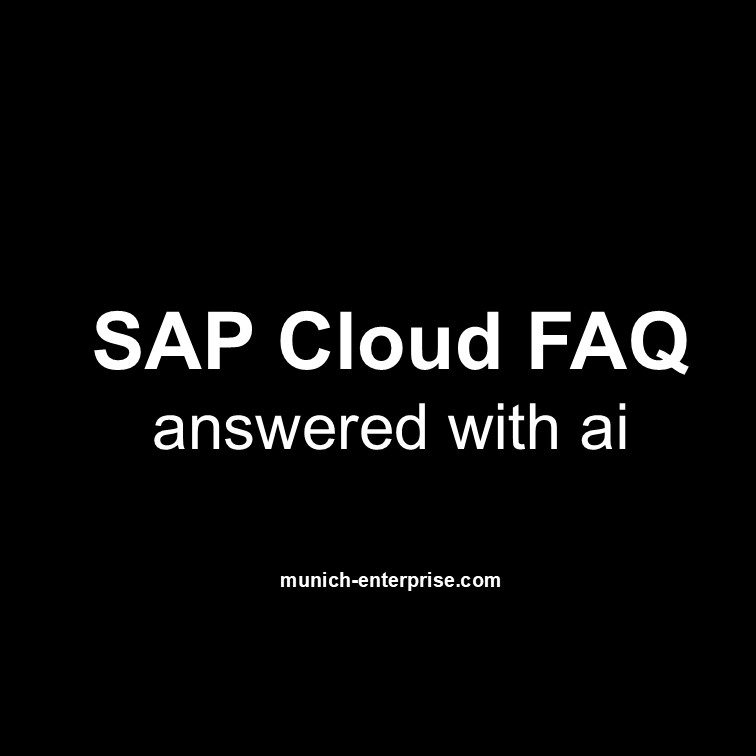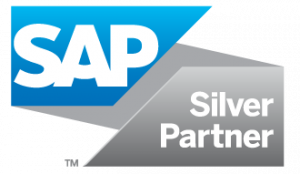Cloud. AI. Change. – How SAP is leading companies into the future
Never before has technological change been as rapid as it is today. Artificial intelligence is changing business models, the cloud is transforming IT landscapes – and in the middle of it: SAP. If you ask the right questions now, you will set the course for tomorrow. In this article, we highlight the most important topics, challenges, and opportunities surrounding SAP’s journey to the cloud and the use of AI. Clear, practical and with a view to what really counts: more efficiency, more innovation, more future.
Table of Contents

A glimpse into the future of SAP – answered by AI
In conversations with customers, partners, and interested parties, key questions about the SAP world regularly arise: For whom is the SAP S/4HANA Public Cloud suitable? And what is the difference between on-premise and private cloud?
In order to answer these and other questions in a well-founded and efficient way, we tried a new method this time: We surveyed the artificial intelligence ChatGPT. The answers you will read in the following article come directly from the dialogue with AI – practical, compact and up to date.
Of course, we carefully check all content and, if necessary, supplement it with our own experience from our SAP projects. Have fun reading – and if you have any questions, please feel free to contact us!
Your team of munich enterprise software GmbH
For which customers will the SAP S/4HANA Public Cloud be interesting in the future?
The SAP S/4HANA Public Cloud (also known as SAP S/4HANA Cloud, Public Edition) is particularly interesting for customers who have clear requirements in terms of standardization, rapid adoption, and low IT operating costs.
Here is an overview of which customer groups it is particularly suitable for:
Suitable for:
Medium-sized companies
-
with standardized business processes
-
who want to work productively quickly (time-to-value)
-
with limited IT resources
-
Focus on OPEX instead of CAPEX (cloud = monthly instead of investments)
Subsidiaries of large companies
-
as a standard solution for international subsidiaries
-
with central SAP ECC or S/4HANA at the headquarters (two-tier ERP)
Companies with clear compliance requirements
-
SAP Public Cloud complies with many standards out-of-the-box (e.g. GDPR, ISO certifications)
Cloud-first organizations
-
with a strategic goal for a complete cloud migration
-
that focus on innovation and agility
Less suitable for:
-
Companies with very individual ABAP adjustments
-
Industries with complex processes or many interfaces to third-party software
-
Customers who need local control over the system or legacy integrations
Typical target industries:
-
Service company
-
Retail / E-Commerce
-
Startups with rapid growth
-
Technology
-
Subsidiaries abroad
What is the difference between on-premise and private cloud at SAP?
The difference between on-premise and private cloud at SAP (e.g. S/4HANA) lies mainly in the type of operation and the responsibility for the system environment – not necessarily in the software itself.
Here are the most important differences:
On-premise
-
System is up to the customer (own data center or hosting partner)
-
Customer is fully responsible for:
-
Hardware / Infrastructure
-
Operating system, database, SAP basis
-
Updates, upgrades, backups, security
-
-
Full flexibility for individual adjustments (ABAP, modifications)
-
Typical for large companies with their own IT or high customization needs
Private cloud (e.g. SAP S/4HANA Private Cloud Edition)
-
System is hosted by SAP or hyperscaler (e.g. AWS, Azure)
-
SAP takes care of the operation (via SAP RISE or hosting partner)
-
Customer retains the possibility of customization (ABAP, own add-ons)
-
Usually faster project runtimes than on-premise, but with higher standardization than public cloud
-
Maintenance and updates are planned together (more predictability)
In short:
| Feature | On-premise | Private Cloud |
|---|---|---|
| Hosting | At the customer’s site | At SAP / Hyperscaler |
| Responsibility for IT operations | Customer | SAP or partner |
| Adaptations | Fully flexible | Very flexible (almost like on-premise) |
| Upgrades/Updates | Manual, freely plannable | By arrangement, carried out by SAP |
| TCO (Cost) | Higher initial cost of ownership (CAPEX) | OPEX model with predictable costs |
What is SAP Joule – and how can the AI Copilot be used in the SAP HANA private cloud or in an on-premise installation?
SAP Joule is a modern, generative AI co-pilot that is deeply integrated into the SAP world. It uses natural language input to help users analyze data, perform tasks, and make informed decisions. Joule understands the business context and can provide relevant information or initiate processes in real time – without the user having to manually navigate through different transactions.
Use in the SAP HANA Private Cloud:
SAP Joule can be used in SAP S/4HANA Private Cloud Edition (e.g. as part of SAP RISE) if:
-
The current version of SAP S/4HANA is used,
-
SAP Business Technology Platform (BTP),
-
the corresponding AI services are activated and licensed.
This environment offers the necessary flexibility for individual expansions – at the same time, it enables the use of modern SAP innovations such as Joule.
Usage in an on-premise installation:
SAP Joule is currently not intended to be used for classic on-premise systems (SAP S/4HANA without cloud components). SAP focuses its AI innovations primarily on cloud models. On-premise customers must either migrate to the private cloud or develop alternative AI integrations themselves.
As an on-premise customer who wants to use SAP Joule, you need a hybrid architecture with certain SAP Cloud components, as Joule is exclusively cloud-based. A purely local (on-premise) use is currently not possible. Here are the key building blocks:
As an on-premise customer who wants to use SAP Joule, you need a hybrid architecture with certain SAP Cloud components, as Joule is exclusively cloud-based. A purely local (on-premise) use is currently not possible. Here are the key building blocks:
Cloud components required for Joule as an on-premise customer
-
SAP Business Technology Platform (SAP BTP)
→ basic requirement for AI services like Joule.
You will need:-
Subscription to SAP BTP
-
Connecting your SAP system to BTP (e.g. via SAP Cloud Connector)
-
-
SAP Build Work Zone (Standard Edition)
→ Serves as the central surface in which Joule is embedded. -
SAP Identity Authentication Service (IAS)
→ authentication and single sign-on for users who are supposed to use Joule. -
Connect your SAP S/4HANA system (on-premise) to SAP BTP
→ For connectivity, access to business objects, and contextual information. -
Activation of Joule functionality via the SAP Support Portal
→ Up-to-date availability and activation through SAP Customer Engagement initiatives, if applicable.
What does this mean for you as an on-premise customer?
You can’t use Joule directly in your on-premise system , but only in combination with these SAP Cloud components – which technically corresponds to a partial migration or expansion towards the cloud.
For which specific use cases can I use the SAP Business Technology Platform (BTP) as an on-premise customer?
Even as an SAP on-premise customer , the SAP Business Technology Platform (BTP) can be used profitably – without migrating completely to the cloud. The BTP enables hybrid architectures and offers a variety of concrete use cases:
Extensions & Custom Apps
With SAP BTP Extension Suite , you can develop custom applications that access your on-premise SAP system via APIs – such as modern Fiori apps, mobile applications, or approval workflows.
Data Integration & Analysis
With SAP BTP Integration Suite and SAP Analytics Cloud , you can integrate and analyze data from your on-premise system – even when combined with non-SAP data sources. Ideal for modern dashboards, reporting or AI-supported evaluations.
Artificial Intelligence & Machine Learning
BTP gives you access to SAP AI Core and AI services – e.g. for document recognition, forecasting models or integration of SAP Joule. These services access your on-premise data without you having to migrate the system.
4. Process automation
With SAP Build Process Automation , you can automate manual processes – such as document approvals, approvals, or notifications – even if your ERP system is running locally.
5. Central user and authorization management
With SAP Identity Services (IAS/IAG), you can consistently map single sign-on, user management, and access control even in hybrid landscapes.
Result: SAP BTP offers on-premise customers the opportunity to integrate modern cloud innovations step by step – without moving the entire ERP system to the cloud. This makes it possible to enter the “cloud world” without jeopardizing the company’s existence.
What is a specific use case for SAP Joule for an on-premise customer?
Even though SAP Joule was originally designed for cloud environments, an on-premise customer with connected SAP BTP can benefit from Joule in a targeted manner – for example, in the purchasing process.
Example: Intelligent support for order approval
A medium-sized company operates its SAP S/4HANA system on-premise, but uses SAP BTP to augment it with AI services. Procurement wants to speed up approval processes and at the same time make more informed decisions.
With SAP Joule, it could look like this:
-
A buyer asks in natural language:
“Are there any risks involved in ordering 4500012345?” -
Joule automatically analyzes relevant data:
-
Supplier default rates
-
Past delivery delays
-
Budget overruns
-
-
The AI provides a short summary + a recommendation for approval or inquiry.
This makes the approval process more transparent, faster, and data-based – without the need for manual research in several SAP transactions.
Result: On-premise customers can also use SAP Joule to build smarter processes – as long as they are connected via SAP BTP. This is particularly worthwhile in areas with many routine decisions, such as purchasing, service or invoice verification.




